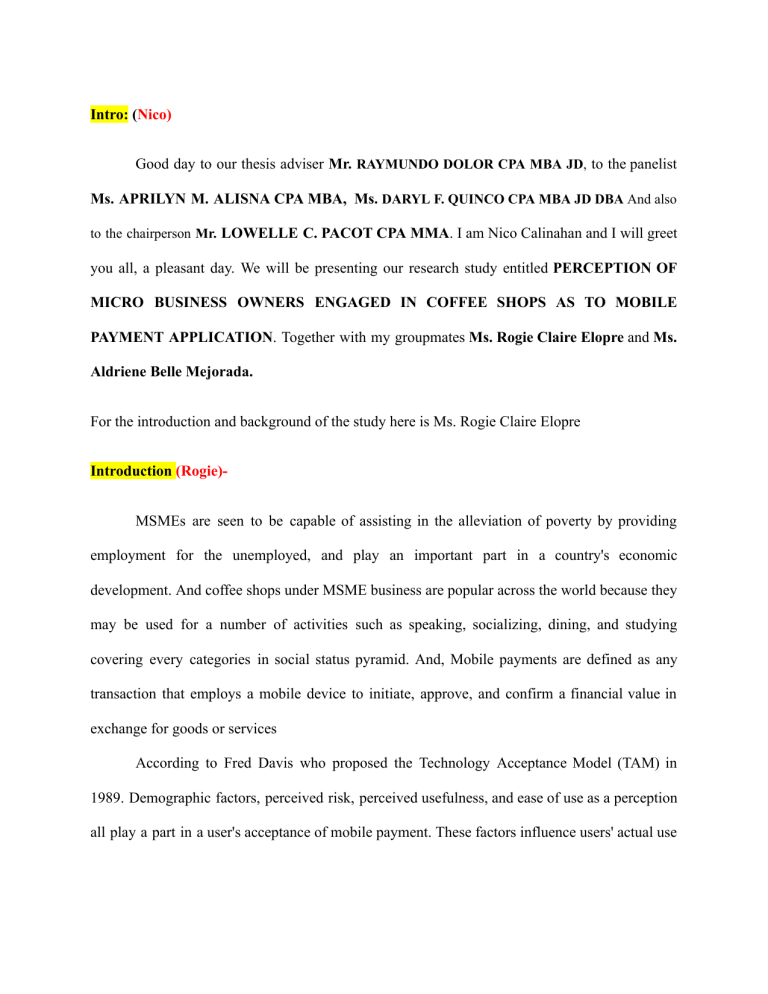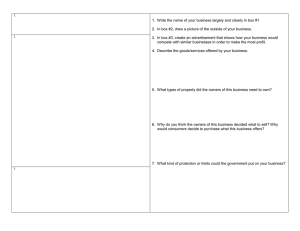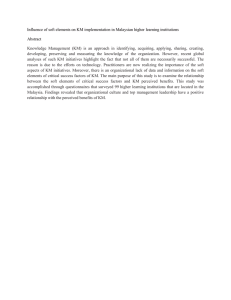
Intro: (Nico) Good day to our thesis adviser Mr. RAYMUNDO DOLOR CPA MBA JD, to the panelist Ms. APRILYN M. ALISNA CPA MBA, Ms. DARYL F. QUINCO CPA MBA JD DBA And also to the chairperson Mr. LOWELLE C. PACOT CPA MMA. I am Nico Calinahan and I will greet you all, a pleasant day. We will be presenting our research study entitled PERCEPTION OF MICRO BUSINESS OWNERS ENGAGED IN COFFEE SHOPS AS TO MOBILE PAYMENT APPLICATION. Together with my groupmates Ms. Rogie Claire Elopre and Ms. Aldriene Belle Mejorada. For the introduction and background of the study here is Ms. Rogie Claire Elopre Introduction (Rogie)MSMEs are seen to be capable of assisting in the alleviation of poverty by providing employment for the unemployed, and play an important part in a country's economic development. And coffee shops under MSME business are popular across the world because they may be used for a number of activities such as speaking, socializing, dining, and studying covering every categories in social status pyramid. And, Mobile payments are defined as any transaction that employs a mobile device to initiate, approve, and confirm a financial value in exchange for goods or services According to Fred Davis who proposed the Technology Acceptance Model (TAM) in 1989. Demographic factors, perceived risk, perceived usefulness, and ease of use as a perception all play a part in a user's acceptance of mobile payment. These factors influence users' actual use and attitude toward using a system, all of which are mediated by their behavioral purpose to use the system in the first place. Although several studies have been conducted on mobile payment adoption, only a few have centered the perceived interactivity and the use of digital technology for micro-business success and growth. This paper investigates the openness and perception of micro-business owners engaged in mobile payments in a coffee shop and further analyzes the users’ attitudes about mobile payment, particularly e-cash and mobile payments. Statement of the Problem (Belle) This study aims to investigate these factors to fill in a knowledge gap and determine that demographic/firm factors, perceived risk, usefulness, ease of use, and social influence, and the intervening variables mentioned above, influence mobile payment acceptance. Specifically, the researchers will answer the following: 1. What is the impact of demographic factors on mobile payment acceptance? 2. What are the perceived advantages and disadvantages of mobile payment applications? 3. What is the degree of acceptance of mobile payment applications by business owners? Methodology (Nico) This study uses a hundred percent sampling, in which 7 out of 9 coffee shop owners in Misamis Occidental that their businesses are registered under the Department of Trade and Industry as of January 2022 spend their time to respond to our survey questionnaire in descriptive correlation as a research design under quantitative methods. The questions designed in line with the Likert scale, ranging from strongly agree (4) to strongly disagree (1), were then computed for further analysis using weighted average analysis to have an accurate interpretation of the data gathered. This is the scale used in determining to what level demographic factors and the degree of acceptance that affect coffee shop owners in adopting mobile payment: Demographic Profile (Nico) Part A of our questionnaire survey, we ask our respndents for their demographuc profile As illustrated in Table 1.1, it shows the gender of respondents, in which the majority of the respondents (57.14%) were male and 42.86% were female. - ---Table 1.2 shows that the majority of the respondents (42.86%) are between the ages of 41 years and above. Participants ages 31 to 40 made up 28.57 percent of the total. And only 2 of the participants were between the ages of 21 and 30, and none were under the age of 20. - ---Table 1.3 shows that 7 of the respondents, constituting 71.43%, were at their postgraduate level, while 28.57% had college or university education. - ---Table 1.4 indicates the type of ownership of the coffee shops; 85.71% of the respondents' businesses are owned and operated by proprietors. 14.29% is owned by a partner, and none of them is owned by a corporation. - ---- The distribution of coffee shops by the number of years they've been in operation is shown in Table 1.5. It shows that 71.43% of the coffee shops have been operating for less than 2 years. While 28.57% have been in operation for 2 to 5 years and none have been in operation for more than 5 years. - ---Table 1.6 shows that all of the respondents utilize Gcash as a platform for managing cashless payments in their enterprises. This indicates that the respondents' businesses have already used the mobile payment method. This was not surprising given that the majority of Filipino respondents claimed they preferred GCash over other e-wallet firms in a recent study done in 2021. (Rogie) The following tables will show to what level the demographics factors affect the perception of micro business owners engaged in coffee shops as to mobile payment. For the category under Perceived Risk (Rogie) This section had four indicators, which were coded as PR1, PR2, PR3, and PR4 As to Gender As shown in Table 2.1 the Perceived risk of mobile payment system as to gender, it indicates that female coffee shop owners perceived risk at High Level in using mobile payment systems with an average weighted mean of 2.83 than male coffee shop owners with an average weighted mean of 2.81. - ---- As to Age Table 2.2 shows the perceived risk of mobile payment system as to age, it indicates that ages between 31 to 40 years old coffee shop owners perceived risk at High Level in using mobile payment systems with an average weighted mean of 3.00 than ages between 21-30 years old and 41 years old and above which has an average weighted mean of 2.38 and 2.84 respectively. - ---- As to Educational Attainment In this table, it shows the perceived risk of mobile payment systems as to the education attainment of the respondents in which College coffee shop owners perceived risk at High Level in using mobile payment systems with an average weighted mean of 2.88 than those in postgraduate level with an average weighted mean of 2.70. Perceived Usefulness (Nico) This section has five indicators, which were coded as PU1, PU2, PU3, PU4 and PU5 As to Gender As shown in Table 3.1 it indicates that male coffee shop owners perceived usefulness at a High Level in using mobile payment systems with an average weighted mean of 3.35 than female coffee shop owners with an average weighted mean of 1.95. - ---- When it comes to Age As shown in Table 3.2 it indicates that ages 41 years old and above coffee shop owners perceived usefulness at a High Level in using mobile payment systems with an average weighted mean of 3.35 than ages between 21-30 years old and 31-40 years old which has an average weighted mean of 2.00 and 3.00 respectively. - ---- As to Educational Attainment In this table, it shows that postgraduate coffee shop owners perceived usefulness at a High Level in using mobile payment systems with an average weighted mean of 3.20 than those in college level with an average weighted mean of 2.30. - ---- Perceived Ease of Use (Belle) This section has three indicators, which were coded as PEU1, PEU2 and PEU3 - ---- As to Gender As shown in Table 4.1 the Perceived ease of use of mobile payment systems as to gender, it indicates that female coffee shop owners perceived ease of use at a Very High Level in using mobile payment systems with an average weighted mean of 3.78. than male coffee shop owners with an average weighted mean of 3.25 - ---- As to Age Table 4.2 shows the perceived ease of use of mobile payment systems as to age, it indicates that ages 41 years old and above coffee shop owners perceived ease of use at a Very High Level in using mobile payment systems with an average weighted mean of 3.67 than ages between 21-30 years old and 31-40 years old which has an average weighted mean of 3.17 and 3.00 respectively. - ---- As to Educational Attainment In this table, it shows the perceived usefulness of mobile payment systems as to the education attainment of the respondents in which college coffee shop owners perceived ease of use at a Very High Level in using mobile payment systems with an average weighted mean of 3.50 than those in postgraduate level with an average weighted mean of 3.40 Social Influence (Nico) This section has five indicators, which were coded as SI1, SI2, SI3, SI4 and SI5. - ---- As to Gender As shown in Table 5.1 it indicates that female coffee shop owners are socially influenced in using mobile payment systems at a High Level based on the average weighted mean of 3.07 than male coffee shop owners with an average weighted mean of 2.50 - ---- As to Age Table 5.2 shows the social influence as to age, it indicates that ages between 31 to 40 years old and 41 years old above coffee shop owners are socially influenced in using mobile payment systems at a High Level based on their average weighted mean of 3.00 than ages between 21-30 years old which has an average weighted mean of 2.30. - ---- As to Educational Attainment In this table, it shows that postgraduate coffee shop owners are socially influenced in using mobile payment systems at a High Level based on the average weighted mean of 2.88 than those in college level with an average weighted mean of 2.50 - ---- Perceived Advantage and Disadvantages (Rogie) The following figures will show what are the perceived advantages and disadvantages in acceptance of mobile payment. - ---According to the figure, one of the advantages of using mobile money payment is the low risks of abusing user’s information and billing information, since mobile payment methods offered by major providers are more secure than physical cards and cash. On the contrary, owners are also concerned about the security of transactions, since mobile transactions are not immune to intrusions by hackers and identity thieves, which can lead to unexpected problems. - ---- Perceived Usefulness as to Perceived Advantage and Disadvantage For the next slide, it shows the perceptions of every respondent regarding perceived usefulness of using mobile payment. From the participants' response, they believe that using mobile money payment helps them do their finance-related job more effectively and efficiently, especially in carrying out transactions, finding it helpful in paying and receiving services. Perceived Ease of Use as to Perceived Advantage and Disadvantage The next figure shows the perceptions of every respondent regarding perceived ease of use of using mobile payment. According to the figure ,participants perceived that it is user-friendly and since it is convenient with the current technology trend, it will help business operations to transact faster. Degree of Acceptance (Belle) The following tables will show what level of the degree of acceptance of microbusiness owners engaged in coffee shops as to mobile payment. - ---For Table 6 Perceived risk under the degree of acceptance of coffee shop owners' actual use and perception toward using a mobile payment system is at a High Level. This indicates that the perceived risk is a high concern for them based on the average weighted mean of 2.82. - ---In Table 7, The overall mean score of the items of this construct was 2.11, perceived usefulness under the degree of acceptance of coffee shop owners' actual use and perception toward using a mobile payment system is at a Moderate Level This indicates that the perception of usefulness is only a moderate concern for the coffee shop owners when accepting mobile money payment. - ---As shown in Table 8, With the advancement of technology, consumers have developed their own technology that enables mobile transactions and makes them more transparent and convenient, which makes mobile money payment easier to carry out transactions. Respondents' responses as the table shown above indicates a mean of 3.33 which is relatively a High Level . Findings (Nico) - base sa PPT The findings were formulated based on the results in Chapter 3 and presented according to the order of the Statement of the Problem in Chapter 1. The researchers found the following: Conclusions (Belle) - base sa PPT Recommendations (Rogie) - base sa PPT Based on the findings and conclusions of this study, the researchers have come up with the following recommendations: It should be noted that this analysis has few limitations. Firstly, due to a finite time of research, this study focused on coffee shop owners in Misamis Occidental which may not best represent microbusiness owners.

